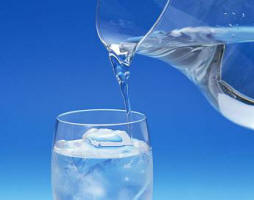 In Ethiopia, UNICEF helps meet water supply challenges in drought-hit Raya Azebo district
In Ethiopia, UNICEF helps meet water supply challenges in drought-hit Raya Azebo district
AZEBO, Ethiopia, 1 July 2011 – Tilalem Kiros, 13, a seventh grader in Raya Azebo district in the Tigray Region of northern Ethiopia, wants to be a doctor when she grows up. But she fears her daily struggle for water will ultimately prevent her.Three times a week Tilalem and her mother Medhin fetch water from the closest source of water, a spring that flows down the mountain behind their village. It takes them more than an hour to walk there, leaving Tilalem – who has been helping her mother since she was nine – often too tired to attend school. Her grades are now slipping as a result.
There is little choice. “If we don’t get up early in the morning the water will get spoiled. People who live above here will wash in the water, polluting it,” explains Medhin. “When the sun is overbearing there are times when the spring dries up, then we are forced to use the rain-fed ponds. That water is not good.”
Some days they have to wait hours to get their turn, as other women and girls fill up their containers. The return journey carrying 25 litres of water each on their backs across the mountainous terrain is an ordeal that they bear in silence.
“It is very heavy, it is water after all,” says Medhin. “The rope digs into our shoulders, it swells and gets sore. Because I don’t have a donkey, it is my daughter and me who must carry the water.”In Raya Azebo, access to a safe water supply is only 49 per cent, according to the district water office. And the Government definition of access means that a year-round improved water source exists within 1.5 km of the home, so even people with access to safe water face a long walk.
Raya Azebo also is a drought-prone district with limited sources of easily accessible water. “The most reliable year-round water sources in that district are deep wells. So providing access to a safe water supply often requires a significant amount of funding,” says UNICEF WASH Project Officer Leul Fisseha.
UNICEF, in partnership with the Regional Water Bureau, is working to improve access to safe water and sanitation. At the moment this means bringing in water by tanker but the aim is to install a deep well and water distribution system.
“Providing potable water to the most vulnerable, like the people in this district, has many tangible benefits,” said Mr. Fisseha. Bringing water near homes will give children more time to study and improve sanitation and hygiene, which will also result in fewer incidences of diarrhoeal diseases.
Shefena Habte Hagos lives in the village of Jalla in Raya Azebo where UNICEF has already supported the installation of a deep well water system, like the one needed in Ebo Village.
“When we went to fetch water in the place called Oda, we would spend the whole day there,” says Ms. Hagos. “It was so far away, we would have to spend the night there, and the children would go hungry. But now that the water point is close by, we fetch water in peace and we are able to give our children lunch and dinner – they no longer have to go to bed hungry.”
There has been a great deal of progress in the Water, Sanitation and Hygiene (WASH) sector in Ethiopia during the past five years, much of it achieved through joint partnership programmes between the Government and organizations such as UNICEF.
Much still remains to be done, however. According to Government figures, about 30 million Ethiopians – out of a total population of 82 million – still lack access to basic sanitation and safe and reliable drinking water. Drought is exacerbating these issues.
The Government of Ethiopia has laid out ambitious plans for water, sanitation and hygiene through its ‘Universal Access Plan’ which seeks to provide people with 98.5 per cent access to safe water and 100 per cent access to sanitation by 2015, which is over and above its Millennium Development Goal targets.
To do this, innovative, cost-effective and sector-wide approaches are needed. UNICEF is supporting the Government and its partners to accomplish this, including:
- Scaling-up of Community-Led Total Sanitation and Hygiene;
- Strengthening WASH sector nationally through a Memorandum of Understanding between the Education, Health, and Water sectors;
- Developing a national handwashing campaign aimed at school children;
- Addressing critical water, sanitation and hygiene needs;
- Expanding WASH activities in Ethiopia’s four “Developing Regional States” where access to basic services is very low;
- Cataloguing all WASH infrastructure around the country to help identify geographic and population groups most in need of investment.
Clean water, healthy lives
Reaching these targets by 2015 could cost as much as $2.3 billion. Current levels of investment are only about a third of this. But as Ms. Hagos can attest, providing safe water is investing the future.
“The old water source was terrible quality, it had frogs living in it, and different types of worms,” she recalls. “Our children would frequently get stomach diseases. But now we drink clean water, and they don’t get sick.”
It also means her children are able to attend school regularly. The hope is that children like Tilalem will soon be able to as well.
| Contact information | n/a |
|---|---|
| News type | Inbrief |
| File link |
http://www.unicef.org/infobycountry/ethiopia_59056.html |
| Source of information | http://www.unicef.org |
| Keyword(s) | water resource, water supply and demand, water supply management, water scarcity, drought |
| Subject(s) | DRINKING WATER , INFORMATION - COMPUTER SCIENCES , POLICY-WATER POLICY AND WATER MANAGEMENT |
| Geographical coverage | Ethiopia, |
| News date | 05/07/2011 |
| Working language(s) | ENGLISH |
 you are not logged in
you are not logged in





